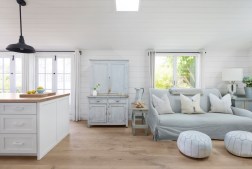The Ultimate Guide to Designing an Eco-Friendly Backyard Oasis
Creating an eco-friendly backyard not only benefits the environment but also provides a tranquil and sustainable space for you and your family to enjoy. By incorporating eco-friendly practices into your backyard design, you can reduce your carbon footprint and create a haven for wildlife. In this ultimate guide, we will explore the various steps you can take to design an eco-friendly backyard oasis.
Sustainable Landscaping
The first step in creating an eco-friendly backyard is to establish a sustainable landscaping plan. This involves choosing native plants that are well-suited to your region’s climate and soil conditions. Native plants have adapted to local environmental conditions and require less water, fertilizer, and maintenance compared to non-native species.

Additionally, consider incorporating edible plants into your landscape design. Growing fruits, vegetables, and herbs not only provides you with fresh produce but also reduces the need for transportation and packaging associated with store-bought food.
Furthermore, minimize the use of chemical fertilizers and pesticides by opting for organic alternatives or natural pest control methods. These practices help protect the soil, water sources, and beneficial insects in your backyard ecosystem.
Water Conservation
Water conservation is another crucial aspect of designing an eco-friendly backyard oasis. Implementing strategies to reduce water usage not only helps conserve this precious resource but also lowers your utility bills.
One effective way to conserve water is by installing a rainwater harvesting system. Collecting rainwater in barrels or cisterns allows you to reuse it for watering plants and lawns during dry spells. This helps offset the need for municipal water supplies while reducing runoff that can cause erosion and pollution.
In addition to rainwater harvesting, consider installing drip irrigation systems instead of traditional sprinklers. Drip irrigation delivers water directly to plant roots while minimizing evaporation loss compared to overhead watering methods.
Lastly, choose drought-tolerant plants that require less frequent watering once established. These plants have adapted to arid conditions and can thrive with minimal irrigation, reducing water consumption in your backyard.
Wildlife-Friendly Design
Designing an eco-friendly backyard involves creating a welcoming habitat for wildlife. By providing food, water, and shelter, you can attract a diverse range of birds, butterflies, bees, and other beneficial insects.
To attract wildlife, incorporate native flowering plants that provide nectar and pollen for pollinators. Planting a variety of flowers that bloom at different times throughout the year ensures a continuous food source for these creatures.
Include bird feeders and birdbaths to provide additional sustenance and water sources. Make sure to clean and refill them regularly to maintain their attractiveness to birds.
To create shelter for wildlife, incorporate trees, shrubs, and grasses into your landscape design. These elements offer nesting sites and cover for animals seeking refuge from predators or extreme weather conditions.
Sustainable Materials
When designing an eco-friendly backyard oasis, it is essential to consider the materials used in construction projects such as patios, walkways, and furniture.
Opt for sustainable materials like reclaimed wood or recycled plastic lumber when building outdoor structures. These materials reduce the demand for new resources while still providing durable options for your backyard design.
Choose environmentally friendly paints or stains when finishing outdoor furniture or structures. Traditional paints often contain harmful chemicals that can leach into the soil or water systems over time.
Furthermore, consider repurposing items instead of buying new ones whenever possible. Upcycling old furniture or containers not only reduces waste but also adds unique character to your backyard oasis.
In conclusion, designing an eco-friendly backyard oasis involves incorporating sustainable landscaping practices, conserving water resources, attracting wildlife through thoughtful design choices, and using environmentally friendly materials. By following these steps and making conscious choices in your backyard design process, you can create a beautiful space that benefits both you and the environment.
This text was generated using a large language model, and select text has been reviewed and moderated for purposes such as readability.


